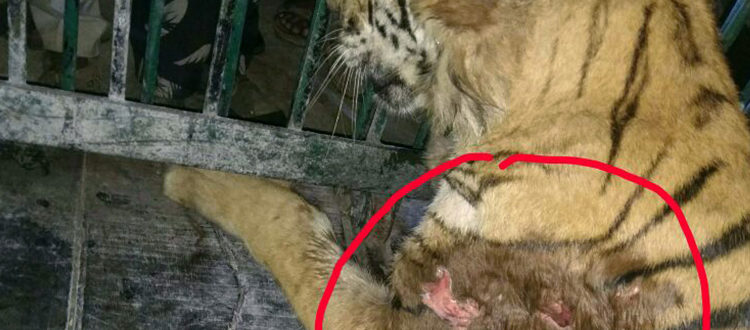Big Cat Conflict: MVS Bandipur Assists Forest Department in Handling Three Cases in Three Days
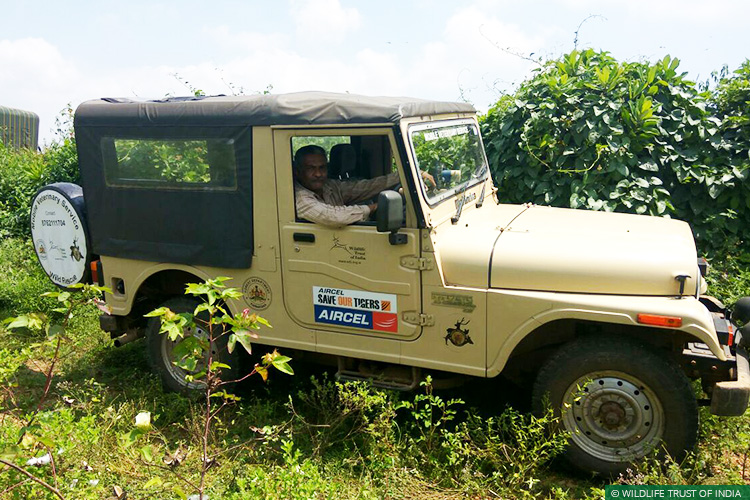 Established in 2015, the MVS Bandipur unit was the first of its kind in South India
Established in 2015, the MVS Bandipur unit was the first of its kind in South India
Bandipur Tiger Reserve, Karnataka, October 15, 2017: Wildlife Trust of India’s Mobile Veterinary Service (MVS) unit, run with support from the Karnataka Forest Department and Aircel Ltd, had a busy three days attending to a succession of large carnivore conflict cases reported from Bandipur and Nagarhole Tiger Reserves last week.
INCIDENT 1
The first case was reported from Dodburgi in the Hediyala sub-division of Bandipur Tiger Reserve on October 9. The forest department was informed that a local woman had been attacked by a large carnivore in a cotton field barely 200 metres from the village. The department requested the MVS unit to assist it in identifying the animal and driving it away from the area if required.
Upon reaching the spot, the team learned that the woman in question had gone to her field the previous morning, where she happened upon a tiger that was consuming two calves which it had killed. The tiger attacked her, inflicting some gaping wounds that, thankfully, were not of a very serious nature. The villagers said that they had seen the animal later that night as well, and that it was possibly still in the field, devouring its kills. They also reported that the animal was known to frequent the area and was often sighted near the cotton field.
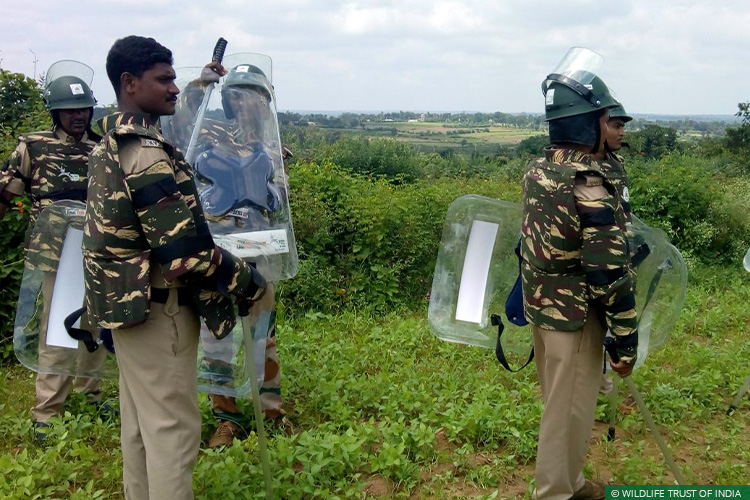 Members of the Karnataka Special Tiger Protection Force (STPF) in conflict mitigation gear donated by WTI and Aircel
Members of the Karnataka Special Tiger Protection Force (STPF) in conflict mitigation gear donated by WTI and Aircel
The Karnataka Forest Department had already placed a baited trap cage at the site. However, as the forest boundary lay barely a kilometre or two from the field, it was thought better to comb the area and allow the animal free passage back into the forest. The combing was conducted with a JCB excavator on one side of the field and a line of people with firecrackers and guns on two other sides.
Barely 10 minutes into the operation Mr Parmesh, the Assistant Conservator of Forests, Hediyala, who was sitting in the JCB, noticed the tiger lying in the cotton field just three metres from an adjacent road. The animal looked extremely dehydrated, debilitated and possibly injured. Given this development, it was decided that it should be tranquilised and taken to a suitable facility for treatment and monitoring.
A forest department veterinarian was summoned from Mysore and the MVS veterinarian assisted him in darting the tiger from the JCB. Once sedated, the animal was lifted up using nets and carried to the transportation crate. (Both these items had been purchased by WTI with Aircel’s support and handed over to the Karnataka Forest Department.) The local police department was on hand to control the assembled crowd which, fortunately, was not too unruly.
The tiger was transported to Mysore Zoo where it was examined by a team of veterinarians. It was an adult female, possibly in its prime, with puncture wounds on the left fore-shoulder and the ventral aspect of the left thigh. The left eyeball was also found to be injured. Overall, it was in an extremely debilitated state and had possibly gotten injured in a territorial fight with another tiger. It is currently in the Mysore Zoo and will be treated and monitored for the next few days.
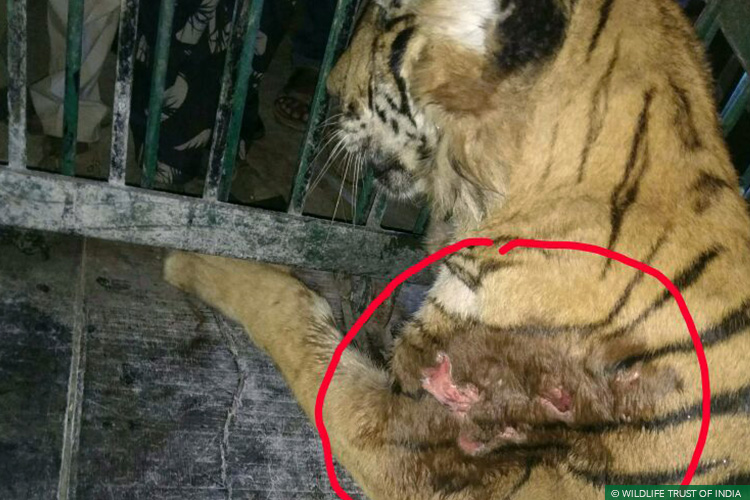 The tiger was in a weakened state and had possibly been injured in a fight for territory with another tiger
The tiger was in a weakened state and had possibly been injured in a fight for territory with another tiger
INCIDENT 2
The MVS team had barely gotten a couple of hours’ sleep when another emergency call came in from the forest department, this time summoning the unit to the Antharsanthe Range of Nagarhole Tiger Reserve. A tiger had supposedly strayed into a village about a kilometre from the forest; locals reported seeing the animal in the cotton fields and said that it had attacked a few heads of livestock within the village.
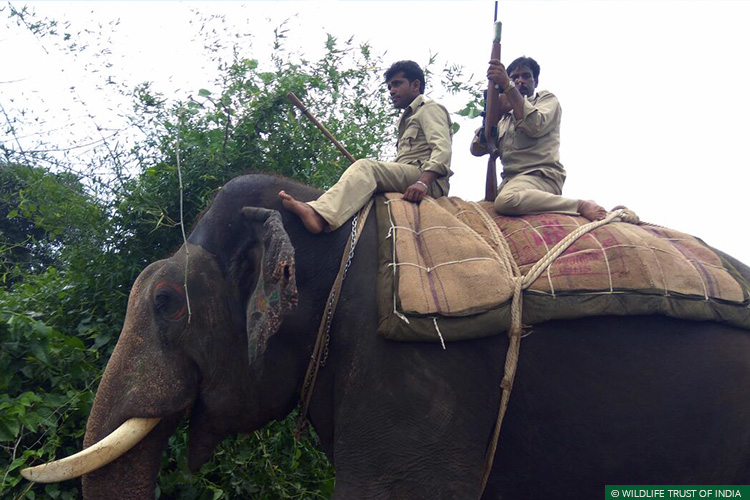 The forest department used kumki elephants to search the area for the tiger
The forest department used kumki elephants to search the area for the tiger
Kumki elephants (captive, trained elephants) were brought in to comb the area, a trap cage was set up and camera traps placed in select areas. At around 3pm, the animal was spotted on a dirt road. It eventually ended up in a cotton field surrounded by irate villagers. The animal’s location was determined from elephant back and given the situation, it was decided that it should be tranquilised and immediately transported out of the area.
A designated forest department shooter darted the tiger from elephant back. The animal ran across a large open expanse before it was completely anaesthetised, whereupon it was placed on a stretcher and covered by a net (both items donated to the forest department by WTI) to prevent interference by the locals. It was then transferred into the transport crate and taken to Mysore Zoo for treatment and observation. It lacked all its canines and was presumably old, but otherwise seemed to be healthy.
INCIDENT 3
On October 11, the MVS team was informed by a villager about the presence of a leopard in the fields at Kongalli village. On reaching the spot, the team found the pugmarks of an adult leopard on the entire one-kilometre stretch of the village road. Locals said that the leopard had been frequenting the area for several years; however, attacks on livestock had increased in the past five months and a villager had been chased by the leopard the previous day.
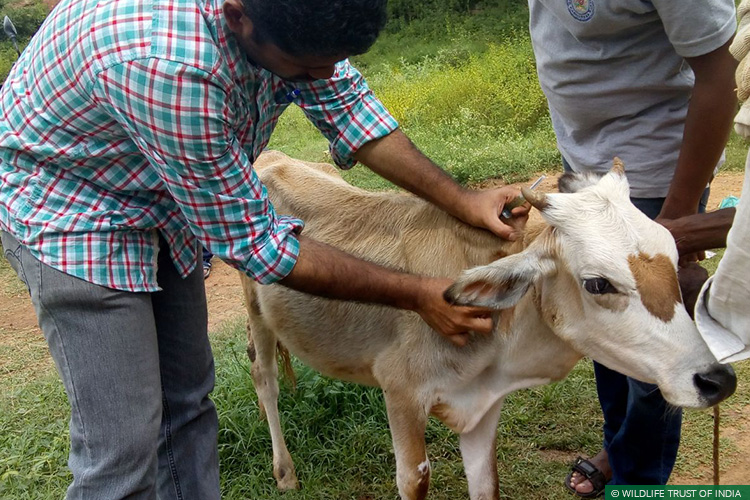 The MVS veterinarian treated a calf that was attacked by the conflict leopard
The MVS veterinarian treated a calf that was attacked by the conflict leopard
While the MVS team was at the village, the leopard attacked a villager and went on to attack a calf. The man was not injured although his clothes were ripped. The calf had bite and scratch marks on its lower neck and the lateral aspect of the abdomen. The MVS veterinarian treated the calf and a baited trap cage was placed in the area in an attempt to capture the leopard.
A report from the field on October 14 suggests that the calf has survived and is recovering from its injuries. Further updates will follow.

